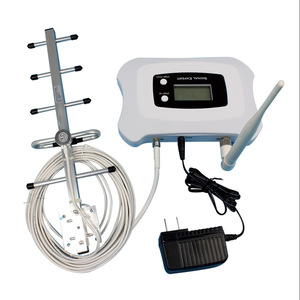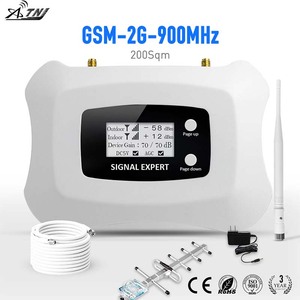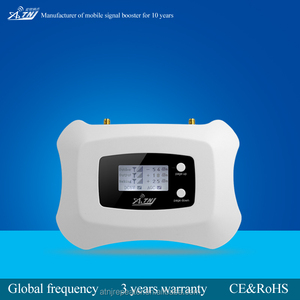
All categories
Featured selections
Trade Assurance
Buyer Central
Help Center
Get the app
Become a supplier

(2542 products available)














































Mobile network receivers are crucial in modern wireless communication. They help users stay connected with the growing demand for fast and reliable mobile networks. From the basics of mobile network receivers to the differences in each type, understanding these devices ensures that businesses choose the right solution to meet their network demands.
Smartphones are the most common devices using mobile network receivers. These receivers pick up signals for calls, messages, and internet data. Newer smartphones have advanced receivers that handle different networks, like 4G and 5G, making them stay connected almost anywhere. They are compact and user-friendly. Thus, they are integral to everyday work for many people who rely on them for business and personal communication.
Mobile satellite receivers are very useful in places where regular networks don't work. They pick up signals from satellites up in space, giving users the ability to always have access. This is especially helpful for people who are far from cities or in areas without good phone service. The signal can be used for calls, internet, and other communications. Satellite receivers are essential for global positioning system (GPS), emergency services, and military operations.
Receivers are found in cars and other vehicles. They enable navigation, music streaming, and basic connectivity. The growing trend of using connected cars makes automotive receivers pivotal in providing smooth travel experience. These receivers keep drivers in touch with traffic info, maps, and other services without needing to stop driving.
Devices using the Internet of Things (IoT) also have mobile network receivers. They help simple devices like sensors or cameras send and get data through networks. In industries where operations need real-time data, IoT receivers are very critical. This makes them an essential tool for many businesses because they enable easy monitoring and control even without cables.
Wearables like smartwatches use mobile network receivers to send and receive data. They keep people connected without phones. Features like fitness tracking, health monitoring, and even emergency alerts are all made possible by these receivers. They provide a level of connectivity that enhances mobility, allowing wearables to be a valuable tool for timely updates and important information while engaged in other activities.
Mobile network receivers must work on many frequency bands to pick up signals well everywhere. The more bands a receiver has, the better it is at getting a good signal. New networks, like 5G, need wide bands to operate fast and efficiently. To help with this, multi-band receivers can be used. They help by covering more frequencies at once, which reduces the chance of getting interference and keeps the signal clear.
Good receivers can detect very weak signals and still give a clear output of data or voice. This is very important, especially in remote areas, as where you are can limit how clear your network connection is. Advanced signal processing helps filter out background noise and boosts signal quality. Technologies like automatic gain control (AGC) and digital signal processing (DSP) allow the receiver to adjust itself to varying signal strengths. This helps maintain a steady and clear connection.
Some receivers are better than others at handling high data rates. Such receivers are vital for tasks that require fast data transfers, like video calls or online uploads. It is also crucial for businesses to check if the receiver can connect to multiple networks, such as LTE, 5G, or Wi-Fi. Network compatibility ensures the device can switch networks smoothly to stay connected without losing signal.
Receivers depend on antennas to pick up signals, and the antenna design can change how well the receiver works. Internal, external, and smart antennas are options that can improve signal strength and reception speed. Also, different connectors are used, and users must ensure their devices match the receiver to avoid issues with the network signals.
Good battery life is often very essential, especially for mobile and wearable devices. This is because they are used throughout the day without the need to plug them in. Efficient receivers help save battery so the device can keep working longer. For industrial devices, quick receivers may cause overheating and affect other parts, so choosing a receiver with low power consumption is ideal for connected devices.
Mobile network receivers are very helpful in remote areas where normal signal reception is hard to get. They allow phone and internet service in places that do not have good coverage. This helps keep towns connected and lets businesses reach clients without being in a big city. They also enable satellite navigation and tracking, making transportation safer and more efficient.
For teams working in the field, like construction workers or energy crews, a mobile receiver helps them stay in touch and share data. This keeps work moving faster and helps with quick decision-making. Even when working far from headquarters, field crews can update their teams and fix problems before they get too big. It is vital for project management and keeping everything on schedule.
Emergency services depend on mobile receivers to stay connected and respond quickly. When making rescue plans or dealing with disasters, staying in touch with teams is vital. They let operators locate and send help where it is needed most. 911 calls and other emergency tasks can be done more smoothly when everyone is connected.
Farmers utilise mobile receivers for precision agriculture. Knowing where things are helps with planting, spraying, and harvesting so nothing is wasted. Farms can operate machines from far away, making work faster and more efficient. This wireless technology lets them check fields, weather, and markets on the go. It turns farming into a tech-savvy business to boost crop yields and profits.
Today, almost every business relies on some form of mobile network receiver. Be it communicating with clients, providing updates to field operations, or tracking shipments in real-time. Thus, enhancing overall efficiency and productivity.
Budget is always an important factor when selecting the right receiver for a mobile network. Basic models cost less upfront, but adding features or upgrades can drive prices up. It is essential to consider how much the receiver will cost over many years. If it needs regular updates or lots of support, it may cost more over time. One must weigh all these factors and choose one that provides the needed performance without exceeding the budget.
For better performance, the receiver must work well in weak signals. Those offerings allow users to connect from farther distances, through walls, or in areas with heavy buildings. It is important to consider the environment where it will mainly be used, as dense areas may block signals more than open ones. Receivers with better sensitivity provide better connections in such challenging environments, ensuring reliability wherever the user is located.
The right receiver for mobile networks needs to manage large amounts of data flow. Bandwidth determines how much data it can handle all at once. A wider bandwidth means faster internet and better performance. Speed is equally important, as too much data online can slow things down, like video conferencing done by many people at once. Choosing a receiver that can handle more modern requirements will pay off with better performance over time.
A receiver for mobile networks must be compatible with current networks. New generations of networks, such as 4G and 5G, are harder to access without the right technology. Dual-band or multi-band receivers provide greater flexibility. They allow users to connect to various networks and ensure the receiver remains effective and relevant in the long run. Choosing one that works on many networks will help avoid problems in the future.
It is also vital to consider how long the receiver will last. This is especially true if the device will be used outside or in heavy work environments, as weather and other elements can impact performance over time. Receivers that protect against dust, moisture, and extreme temperatures increase reliability. This keeps everything running smoothly for as long as possible without having to replace things.
A1: Mobile network receivers have exposed metal parts, such as steel alloy, aluminum, and copper for their cases. Some parts inside the receiver, like components, use ceramic, silicon, and sometimes plastics like polycarbonate to hold them.
A2: Yes, materials impact performance, especially on the antenna and housing. Lightweight metals help the device detect better signals, while sturdy materials protect it in tough environments. These designs reduce signal loss during operation, making it effective indoors and outdoors.
A3: Extreme weather, like storms and high heat, affect receivers. Too much moisture can corrode internal parts, while prolonged heat may damage components. Dust and outdoor elements damage without protection. Choosing durable receivers protects them and ensures a good signal for years.
A4: Keep the receiver dry and ensure no dust or debris gets in. Check it often for wear and tear, mainly if exposed outside, and avoid extreme temperatures. Use a sturdy case for outdoor devices to protect the receiver.
A5: Makers protect receivers using sealed enclosures and shields to block elements, dust, and moisture. Select materials like metals and composites resist extreme weather. Apply protective coatings over receiver parts to ease corrosion and strengthen signals in rugged outdoor scenes.